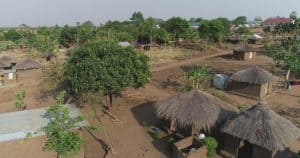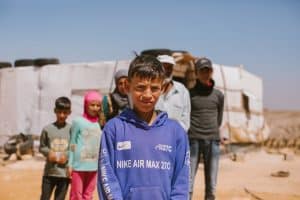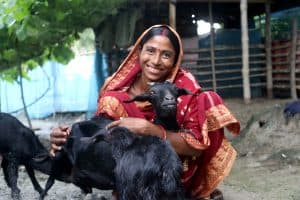Why is hunger on the rise around the world?
- The world produces more than enough food to feed everyone on earth, but availability and access are affected by extreme weather, conflict, and other outside factors.
- Climate change is causing more frequent and intense extreme weather events. Over 80% of the world’s hungry people live in disaster-prone countries.
- The ongoing COVID-19 pandemic has set back crucial progress. Overall, the number of people going hungry has now doubled to 272 million. The crisis has disrupted livelihoods, supply chains, and even the humanitarian resources needed to reach those who are going hungry.
This is Sabomasy’s Story
Sabomasy sits in front of his one-room hut and watches his children prepare supper. The older ones work steadily beside the pot of boiling water while the young ones wait by the fire, quietly anticipating their one meal of the day.
By now, they are accustomed to the bitter flavor of the weeds that grow around their mud hut. It is all there is to eat.
Each day, the children pull native weeds from the dry soil along the pathway. They gather them onto a burlap sack and strip the leaves and boil them in water. Sabomasy, his wife, and his seven children gather together and eat the acrid stew in silence.
Right now, Sabomasy is relaxing while his children cook. The 55-year-old father has been working since dawn to find firewood in the forest. When he does gather enough firewood, he sells it in town. Today, there is no firewood. Tonight, he will eat dinner, go to sleep, and rise at dawn to search again.
“I take my cart to the forest and collect firewood,” he said. “I spend four days looking for and collecting wood. Even if the quantity is small, I will go to town to sell what I can.”
To collect firewood, Sabomasy must walk at least one hour. If there is no wood, he will keep walking. After four days of this, he will walk three hours to the nearest town. If he is lucky, he will sell a cartload of wood for the equivalent of 30 cents. With the money he earns, he will buy a little rice and cassava.
If he is unlucky, he will walk three hours back home empty handed.
“When I can’t buy food, I ask for food from my relatives,” he said. “When there is no food, my children will eat weeds.”
The children are thin and weak, showing the effects of chronic malnourishment.
“The soil is usually good, but there is not enough rain here,” Sabomasy said. “When there is no rain, some of the seeds don’t even sprout. The ones that do don’t grow tall enough.”
As is often the case, hunger is destroying both the social fabric and the future hope that keeps families in crisis afloat.









